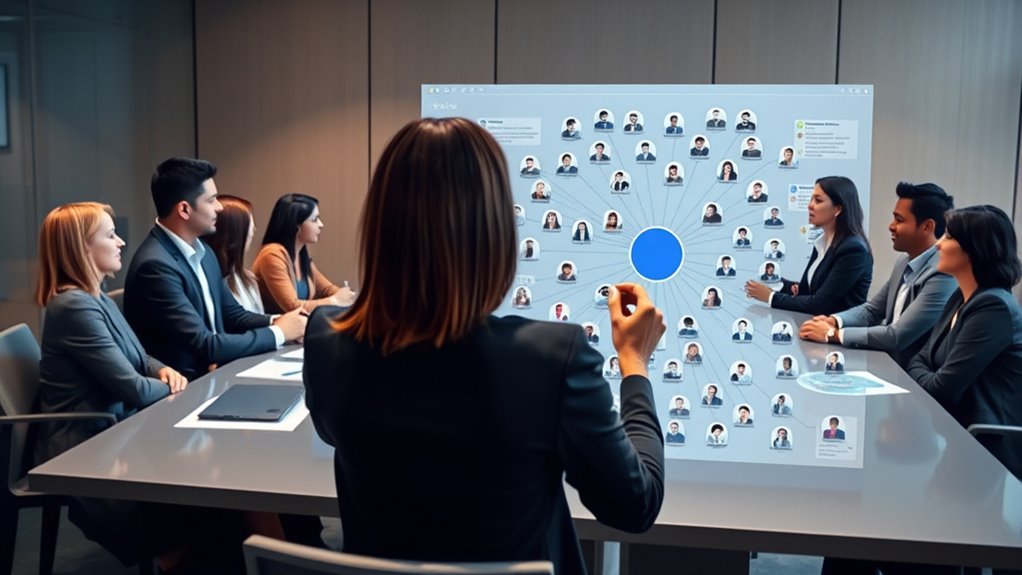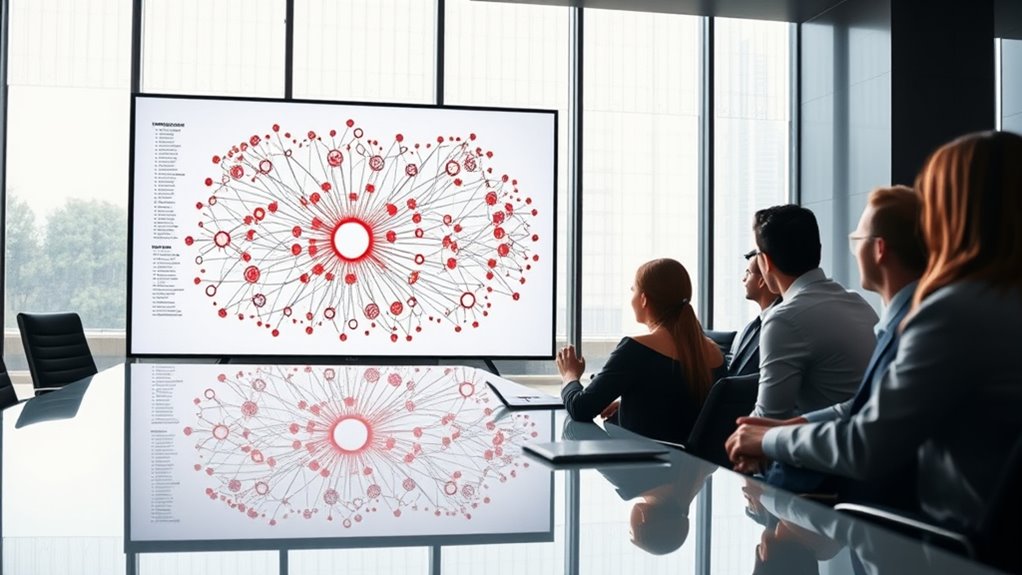Stakeholder mapping helps you identify both visible and hidden influencers who can affect your project. To prevent surprises, analyze communication patterns, social networks, and subtle cues like body language or tone shifts. Recognize power dynamics and influence networks to spot covert agendas or unseen alliances. By actively monitoring and updating your stakeholder map, you stay aware of evolving relationships. Keep exploring to discover practical strategies for uncovering those hidden influencers before they cause disruptions.
Key Takeaways
- Analyze communication patterns and non-verbal cues to detect subtle signs of hidden agendas among stakeholders.
- Leverage social network analysis and data triangulation to uncover covert influence connections.
- Monitor stakeholder interactions for inconsistencies and behaviors indicating hidden motives or interests.
- Map influence networks to identify power asymmetries and unrecognized alliances that could impact project outcomes.
- Regularly update stakeholder maps to capture evolving influence and prevent overlooked hidden influencers from causing surprises.
Understanding the Importance of Stakeholder Mapping

Understanding the importance of stakeholder mapping is essential because it helps you identify who influences or is affected by your project. By engaging in stakeholder identification, you pinpoint key individuals and groups that can impact your success. Influence mapping allows you to visualize these relationships, revealing how different stakeholders might support or oppose your efforts. This process guarantees you’re aware of both visible and less obvious players, enabling you to tailor your communication and strategies accordingly. With clear stakeholder mapping, you reduce surprises and increase your chances of project acceptance. Recognizing the influence others hold early on gives you the power to manage expectations, build alliances, and address concerns proactively. Additionally, understanding emotional support can be crucial when dealing with stakeholders facing personal challenges, ensuring your approach remains compassionate and effective. Ultimately, stakeholder mapping becomes a crucial tool for guiding your project toward smoother execution.
Differentiating Between Visible and Hidden Stakeholders

Have you ever considered that not all stakeholders are immediately visible or obvious? Visible stakeholders often have clear roles, perceived authority, or direct involvement, making them easier to identify. Hidden stakeholders, however, influence your project through implied interests or subtle power dynamics. They may lack formal authority but hold significant sway due to their perceived influence or strategic position. Recognizing the difference helps you avoid overlooking key players who can derail your efforts. Visible stakeholders openly express their concerns, while hidden stakeholders operate behind the scenes, shaping outcomes indirectly. By understanding these distinctions, you can better prioritize your engagement strategies, ensuring you address both obvious and covert influences—preventing surprises that could threaten your project’s success. Being aware of power dynamics within your stakeholder landscape allows for more effective management of these hidden influences.
Techniques for Identifying Covert Influencers

To spot covert influencers, you need to analyze communication patterns for subtle signs of influence. Monitoring social networks helps reveal connections that aren’t immediately visible. Leveraging hidden data allows you to uncover insights that can identify these less obvious but powerful stakeholders. Paying attention to safety features and how users discuss their experiences with heated mattress pads can also provide clues about influential opinions and preferences.
Analyzing Communication Patterns
Analyzing communication patterns is vital for uncovering covert influencers who subtly steer stakeholder dynamics. By paying close attention to non-verbal cues, you can detect underlying emotions and unspoken concerns that reveal hidden motives. Observe body language, facial expressions, and gestures during meetings or conversations. Tone analysis also plays a pivotal role; note shifts in pitch, pace, and volume that might indicate underlying agendas or discomfort. These subtle cues often reveal more than words alone, helping you identify stakeholders who influence decision-making behind the scenes. Consistently evaluating these patterns allows you to spot discrepancies between spoken words and underlying messages. Over time, this insight helps you understand who truly holds sway, guiding your strategies to engage or counteract covert influences effectively. Being aware of hidden motivations enables you to better interpret the full context of stakeholder interactions.
Monitoring Social Networks
Ever wondered how covert influencers operate within social networks? Monitoring social media is key. By observing patterns of interactions, shares, and comments, you can spot subtle signs of influence that aren’t immediately obvious. Network analysis tools help map these connections, revealing hidden nodes that sway opinions behind the scenes. Look for individuals who frequently engage across diverse groups or consistently amplify certain messages without obvious motives. These quiet players often serve as connectors or information brokers, making them powerful despite their low profile. Regularly tracking activity and analyzing engagement metrics allows you to identify these covert influencers early, preventing surprises down the line. Staying attentive to social media dynamics guarantees you don’t overlook the subtle forces that could impact your stakeholder landscape. Additionally, understanding juice detox side effects and benefits can help you maintain your energy and focus while monitoring online activity.
Leveraging Hidden Data
Uncovering covert influencers requires delving into hidden data sources that aren’t immediately visible through surface-level analysis. To do this effectively, use data triangulation—combining insights from multiple sources like email metadata, internal reports, and informal communication channels. This approach helps verify patterns and identify subtle connections. Be mindful of implicit biases that may cloud your judgment; recognize assumptions about influence and question their validity. Analyzing subtle behavioral cues and cross-referencing data points can reveal hidden stakeholders who wield significant sway behind the scenes. Additionally, understanding legal frameworks such as Louisiana alimony laws can help identify financial influences that might otherwise remain unnoticed. By integrating diverse data streams and challenging your biases, you’ll uncover influential figures lurking in the shadows, enabling you to address potential risks before they escalate and ensuring a more extensive stakeholder map.
Analyzing Power Dynamics and Influence Networks

Understanding the power dynamics and influence networks within a stakeholder landscape is essential for effective stakeholder mapping. Power asymmetry highlights how some stakeholders hold more influence than others, shaping decision-making and outcomes. Recognizing these disparities allows you to identify key players who can sway the project’s success or failure. Influence triangulation helps you map relationships and interactions among stakeholders, revealing how influence flows through the network. By analyzing these connections, you can uncover hidden alliances and potential points of leverage. This understanding enables you to anticipate resistance, build strategic alliances, and address concerns proactively. Additionally, being aware of Dog Names can sometimes serve as an icebreaker or a way to build rapport with stakeholders. Ultimately, grasping power dynamics and influence networks provides the insight needed to navigate complex stakeholder environments confidently.
Tools and Frameworks for Effective Stakeholder Analysis

Effective stakeholder analysis relies on a variety of tools and frameworks designed to systematically identify, evaluate, and prioritize stakeholders. Influence matrices are a key tool, helping you visualize each stakeholder’s level of influence versus their interest. This enables clear stakeholder prioritization, ensuring you focus on those who can most impact your project. Additionally, power-interest grids guide you in categorizing stakeholders into groups, allowing tailored communication strategies. Other frameworks, like salience models, consider legitimacy, power, and urgency to determine stakeholder importance. These tools streamline decision-making and help you allocate resources effectively. By applying influence matrices and prioritization techniques, you gain a structured approach to managing stakeholder relationships and mitigating risks before they escalate. Incorporating an understanding of projectors’ contrast ratio can also help anticipate potential image quality issues that may affect stakeholder satisfaction and project success.
Recognizing Subtle Signs of Hidden Agenda

While tools like influence matrices help you identify obvious power dynamics, some stakeholders may still operate behind the scenes with hidden motives. Recognizing subtle cues is key to uncovering their true agenda clues. Pay attention to inconsistent statements, body language, or tone shifts that don’t align with their words. Notice if they repeatedly avoid direct questions or steer conversations toward topics that serve their interests. Small gestures, such as lingering eye contact or nervous fidgeting, can also reveal underlying motives. These subtle signs often signal a hidden agenda, even if the stakeholder appears cooperative on the surface. Additionally, portable camping gear like tents and power sources can be used to mask true intentions during outdoor meetings or clandestine gatherings. By sharpening your awareness of these cues, you can better gauge their real intentions and prevent surprises that could derail your project or decision-making process.
Strategies for Engaging and Managing Influencers

To effectively engage influencers, you need to focus on building trust networks that foster genuine relationships. Tailoring your communication strategies guarantees your message resonates and encourages collaboration. When you align these approaches, managing influencers becomes more strategic and impactful.
Building Trust Networks
Building trust networks that genuinely influence stakeholder engagement requires consistent effort and strategic planning. Trust building is essential for establishing strong connections with key influencers. Start by demonstrating reliability and transparency, showing stakeholders you value honest communication. Focus on network development by identifying mutual interests and aligning goals, which fosters collaboration. Engage consistently, listen actively, and respond thoughtfully to concerns to deepen trust. Recognize that trust isn’t built overnight; it requires patience and ongoing effort. By nurturing these relationships, you create a foundation where influencers feel respected and valued, making them more likely to support your initiatives. Effective network development ultimately enhances stakeholder loyalty and reduces the risk of hidden influences working against your project. Additionally, understanding the importance of interior elements can help create environments that reinforce trust and collaboration.
Tailoring Communication Strategies
Effective engagement with influencers requires tailoring your communication strategies to their specific needs and motivations. Start with audience segmentation to identify different influencer groups and understand their unique concerns. This allows you to craft message customization that resonates with each segment, increasing the chances of meaningful engagement. For example, some influencers may value data-driven insights, while others respond better to personal stories or shared goals. By adjusting your tone, format, and content based on their preferences, you build stronger relationships and foster trust. Remember, one-size-fits-all messaging often falls flat. Instead, focus on delivering targeted messages that align with their interests and influence dynamics. This approach ensures your communication is relevant, impactful, and less likely to be ignored or misunderstood.
Case Studies of Hidden Influencers Impacting Projects

Hidden influencers often shape project outcomes in ways that are not immediately apparent, yet their impact can be profound. In one case, confidential sources revealed insider information that suggested internal resistance from overlooked team members was stalling progress. This hidden influence wasn’t visible through standard stakeholder analysis but became clear when considering subtle cues and unspoken concerns. Another example involved informal networks within an organization, where key individuals quietly swayed decision-making behind the scenes. Recognizing these unseen forces early allowed project leaders to address underlying issues before they escalated. These case studies highlight the importance of looking beyond official roles and gathering sensitive insights. By identifying these hidden influencers, you can prevent surprises and ensure your project stays on track.
Integrating Stakeholder Insights Into Project Planning

To guarantee your project succeeds, integrating stakeholder insights into planning is essential. Start by leveraging influence mapping to identify who holds power and influence over key decisions. This enables you to prioritize stakeholder engagement efforts effectively, ensuring you gather valuable perspectives early on. Incorporate stakeholder feedback into your project goals, timelines, and risk assessments, making your plan more resilient to potential disruptions. By understanding stakeholder interests and influence, you can proactively address concerns, foster support, and reduce resistance. Embedding these insights into your planning process creates a more collaborative approach, increasing the likelihood of project buy-in and success. Ultimately, this integration helps you navigate complex stakeholder landscapes and set a solid foundation for smooth project execution.
Monitoring and Updating Stakeholder Maps Throughout the Project Lifecycle

As your project progresses, it’s essential to regularly reassess your stakeholder map to capture any changes. Updating influence dynamics and tracking shifts in engagement help you stay aligned with stakeholder needs. This ongoing process guarantees your stakeholder strategy remains effective throughout the project lifecycle.
Regular Stakeholder Reassessment
Regular stakeholder reassessment is essential to guarantee your stakeholder map remains accurate and relevant throughout the project lifecycle. As stakeholder dynamics shift, their influence and priorities can change quickly, so keeping your map updated is vital. You should regularly review engagement frequency to ensure you’re maintaining appropriate communication levels with key stakeholders. This ongoing process helps you identify emerging influencers or shifts in existing relationships that could impact your project’s success. By reassessing consistently, you stay ahead of potential issues and maintain a clear understanding of who holds power and interest at each stage. This proactive approach reduces surprises, enhances stakeholder engagement, and guarantees your mapping accurately reflects the current landscape, allowing you to adapt strategies effectively.
Updating Influence Dynamics
Keeping your stakeholder map current requires actively monitoring influence dynamics throughout the project. Influence isn’t static; hidden motives can emerge, shifting a stakeholder’s level of influence or allegiance. By regularly updating your map, you can spot unrecognized allies who may have quietly gained sway or identify hidden motives that threaten progress. Staying alert to these changes helps you adapt your strategy, ensuring you don’t overlook key influencers or misjudge stakeholder priorities. This ongoing process reveals subtle shifts in power and relationships, keeping your project aligned with real-time realities. Remember, influence can evolve quickly—what was a minor supporter yesterday may become a critical ally tomorrow, or vice versa. Continuous updates safeguard your project against surprises caused by unanticipated influence, keeping your stakeholder management sharp and effective.
Tracking Engagement Changes
Monitoring and updating your stakeholder map throughout the project lifecycle is essential to guarantee it remains accurate and relevant. As your project progresses, engagement levels and influence signals will shift, signaling changes in stakeholder priorities or concerns. Regularly tracking these influence signals helps you identify emerging stakeholders or waning interest from others. Feedback loops from ongoing communication provide valuable insights into how stakeholders are responding, enabling you to adjust your approach proactively. By staying attentive to engagement changes, you prevent surprises and maintain strong relationships. Updating your stakeholder map based on these signals ensures that your strategy reflects current realities, keeping you aligned with stakeholder needs and avoiding potential missteps that could derail your project.
Frequently Asked Questions
How Can I Uncover Hidden Influencers in Complex Organizational Structures?
To uncover hidden influencers in complex organizations, you should look beyond formal roles and explore informal networks and informal authority. Engage with colleagues across different departments, attend informal gatherings, and observe who people turn to for advice. Pay attention to unofficial communication channels like social media or chat groups. These insights reveal who truly influences decisions, helping you identify hidden stakeholders before they can cause issues.
What Are Signs That a Stakeholder’s Influence Is Underestimated?
They say, “Still waters run deep,” and that’s true for underestimated stakeholder influence. Signs include shifts in power dynamics, unexpected support, or silent resistance. You might notice bias detection revealing overlooked agendas or influence lurking beneath the surface. When a stakeholder’s impact seems greater than their visible role, it’s a red flag. Stay alert for subtle cues—these often signal hidden power that could sway your project unexpectedly.
How Do Cultural Differences Affect Stakeholder Mapping Accuracy?
Cultural differences can considerably impact stakeholder mapping accuracy because cross-cultural biases may cause you to overlook or misunderstand key influencers. Communication barriers, like language or differing norms, can lead to misinterpretations or missed signals about a stakeholder’s true power or interest. To improve accuracy, you should actively seek diverse perspectives, challenge your assumptions, and adapt your approach to respect different cultural contexts, ensuring you identify all influential stakeholders effectively.
Can Stakeholder Mapping Predict Future Shifts in Influence Dynamics?
While influence forecasting offers valuable insights, it’s important to remember that predicting future shifts isn’t foolproof. With predictive analytics, you can spot emerging trends and adjust your strategies accordingly. However, external factors and unforeseen events can always sway influence dynamics. So, think of stakeholder mapping as a helpful compass—guiding you through potential changes, but remaining flexible as the landscape evolves.
What Ethical Considerations Arise When Identifying Covert Stakeholders?
When identifying covert stakeholders, you face ethical issues like maintaining confidentiality concerns and avoiding bias mitigation. You must guarantee sensitive information isn’t disclosed improperly, respecting privacy boundaries. It’s vital to approach this process objectively, avoiding assumptions that could lead to bias. By balancing transparency with discretion, you protect individuals’ rights while gaining valuable insights, fostering trust and integrity in your stakeholder engagement efforts.
Conclusion
Remember, uncovering hidden influencers isn’t just about spotting shadows in the dark—it’s about shining a light on the unseen forces that can make or break your project. By mapping stakeholders carefully, you can navigate the complex web of influence with confidence. Don’t let silent power players catch you off guard; instead, turn their influence into your strategic advantage. After all, in stakeholder management, awareness is your most powerful tool.







